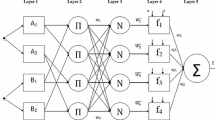Abstract
An extension method is proposed to solve a class of fully fuzzy Sylvester matrix equation (FFSME) under some mild assumptions. This method consists of two steps. Firstly, the fully fuzzy system is transferred into a series of interval Sylvester matrix equations through \(\alpha \)-cut. Secondly, these interval systems are extended into crisp systems which is easy to be solved. The solutions of FFSME are not presumed to be triangular-type fuzzy numbers. Moreover, some examples are presented to show the validity of our method.


Similar content being viewed by others
References
Antoulas AC (2005) Approximation of large-scale dynamical systems. SIAM, Philadelphia, PA
Babbar N, Kumar A, Bansal A (2013) Solving fully fuzzy linear system with arbitrary triangular fuzzy numbers \((m,\alpha, \beta )\). Soft Comput 17(4):691–702
Bartels RH, Stewart GW (1972) Solution of the matrix equation AX +XB = C. Commun ACM 15(9):820–826
Basaran MA (2012) Calculating fuzzy inverse matrix using fuzzy linear equation system. Appl Soft Comput 12(6):1810–1813
Bouhamidi A, Jbilou K (2007) Sylvester Tikhonov-regularization methods in image restoration. J Comput Appl Math 206(1):86–98
Buckley JJ (1990) Fuzzy eigenvalues and input-output analysis. Fuzzy Sets Syst 34(2):187–195
Buckley JJ (1992) Solving fuzzy equations in economics and finance. Fuzzy Sets Syst 48(3):289–296
Buckley JJ, Eslami E, Feuring T (2002) Fuzzy mathematics in economics and engineering. Springer, Berlin
Dookhitram K, Lollchund R, Tripathi RK, Bhuruth M (2015) Fully fuzzy Sylvester matrix equation. J Intell Fuzzy Syst 28(5):2199–2211
Dubois DJ (1980) Fuzzy sets and systems: theory and applications, vol 144. Academic Press, Cambridge
Fernando KV, Nicholson H (1983) On the structure of balanced and other principal representations of SISO systems. IEEE Trans Automat Contr 28(2):228–231
Fortin J, Dubois D, Fargier H (2008) Gradual numbers and their application to fuzzy interval analysis. IEEE Trans Fuzzy Syst 16(2):388–402
Friedman M, Ma M, Kandel A (1998) Fuzzy linear systems. Fuzzy Sets Syst 96(2):201–209
Ghanbari R, Mahdavi-Amiri N (2015) Fuzzy LR linear systems: quadratic and least square models to characterize exact solutions and an algorithm to compute approximate solutions. Soft Comput 19(1):205–216
Goetschel R Jr, Voxman W (1986) Elementary fuzzy calculus. Fuzzy Sets Syst 18(1):31–43
Golub G, Nash S, Van Loan CF (1979) A Hessenberg–Schur method for the problem AX +XB = C. IEEE Trans Automat Control 24(6):909–913
Guo X, Shang D (2013) Approximate solution of LR fuzzy Sylvester matrix equations. J Appl Math 1–10:2013
Hammarling SJ (1982) Numerical solution of the stable, non-negative definite Lyapunov equation. IMA J Numer Anal 2(3):303–323
He Q, Hou L, Zhou J (2017) The solution of fuzzy Sylvester matrix equation. Soft Comput pp 1–9
Hyland DC, Bernstein DS (1984) The optimal projection equations for fixed-order dynamic compensation. IEEE Trans Automat Contrib 29(11):1034–1037
Jones A, Kaufmann A, Zimmermann HJ (2012) Fuzzy sets theory and applications, vol 177. Springer, Berlin
Kressner D (2008) Block variants of Hammarling’s method for solving Lyapunov equations. ACM Trans Math Softw 34(1):1
Liu HK (2010) On the solution of fully fuzzy linear systems. Int J Comput Math Sci 4(1):29–33
Lu A, Wachspress EL (1991) Solution of Lyapunov equations by alternating direction implicit iteration. Comput Math Appl 21(9):43–58
Peeva K (1992) Fuzzy linear systems. Fuzzy Sets Syst 49(3):339–355
Raich VV, Triphath, RK, Bawa, NPS, Dookhitram, K, Dayal, SK (2011) Application of interval valued fuzzy matrices in medical diagnosis via a new approach. In: 2011 International Conference on Multimedia Technology, pp 3440–3443. IEEE
Salkuyeh DK (2011) On the solution of the fuzzy Sylvester matrix equation. Soft Comput 15(5):953–961
Simoncini V (2016) Computational methods for linear matrix equations. SIAM Rev 58(3):377–441
Smith RA (1968) Matrix equation \({X}{A} + {B}{X} = {C}\). SIAM J Appl Math 16(1):198–201
Sorensen DC, Zhou Y (2003) Direct methods for matrix Sylvester and Lyapunov equations. J Appl Math Comput 2003(6):277–303
Triphathi RK, Raich VV, Dookhitra K, Dayal SK, Hareesh AS (2012) Similarity between max min and riv technique with reference to two diseases diarrhea and diabetes. In: National Conference on Computational Intelligence and Signal Processing, pp 170–174
Wachspress E (1998) Iterative solution of the Lyapunov matrix equation. Appl Math Lett 1(1):87–90
Author information
Authors and Affiliations
Corresponding author
Ethics declarations
Conflict of interest
All authors of this paper have no conflict of interest.
Ethical approval
This article does not contain any studies with human participants or animals performed by any of the authors.
Additional information
Publisher's Note
Springer Nature remains neutral with regard to jurisdictional claims in published maps and institutional affiliations.
Supported by the National Natural Science Foundation of China (No. 12071088).
Rights and permissions
About this article
Cite this article
Hou, L., Zhou, J. & He, Q. An extension method for fully fuzzy Sylvester matrix equation. Soft Comput 25, 5763–5774 (2021). https://doi.org/10.1007/s00500-021-05573-z
Published:
Issue Date:
DOI: https://doi.org/10.1007/s00500-021-05573-z




